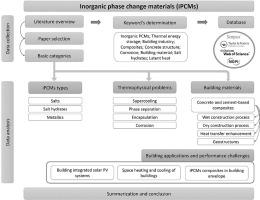Energy and Buildings ( IF 6.7 ) Pub Date : 2021-09-09 , DOI: 10.1016/j.enbuild.2021.111443 Muhammad Faisal Junaid 1, 2 , Zia ur Rehman 3, 4 , Miroslav Čekon 1, 5 , Jakub Čurpek 1, 5 , Rashid Farooq 6, 7 , Hongzhi Cui 2 , Imran Khan 8, 9

|
Reutilization of thermal energy according to building demands constitutes an important step in a low carbon/green campaign. Phase change materials (PCMs) can address these problems related to the energy and environment through thermal energy storage (TES), where they can considerably enhance energy efficiency and sustainability. Concrete researches focusing on building materials revealed a vast potential of inorganic PCMs (iPCMs) utilization in thermal energy management systems particularly in the building applications as per literature; however, large but scattered literature is available on this research dimension. The current study presents an up-to-date review on iPCMs in the context of latent TES in the building sector: summarizing its performance, applications, and key challenges. The thermal performance of iPCMs is based on the higher heat storage capacity per unit volume together with lower cost value in contrast to other latent heat-based materials. However, several crucial challenges associated with iPCMs i.e., supercooling, encapsulation, phase separation, and corrosion issues are identified and discussed, which marginalize its performance in the progressive building applications. Furthermore, different proposed solutions to mitigate these issues are also comprehensively discussed. Likewise, passive and active integrations of iPCMs are systematically analyzed with building materials such as concrete, composites and novel structures with progressive technologies, most commonly used in buildings. In view of the actual challenges to building implementation, though the valuable research data on iPCMs is available in the literature, there still exist inconsistencies in both their fundamental research and development aspects and further real-scale applications. Hence, the current review addresses the profound insight into future perspectives based on the pertinent data of recent technological advances in this field.
中文翻译:

热能储存中的无机相变材料:建筑应用前景和技术进步综述
根据建筑需求重新利用热能是低碳/绿色运动的重要一步。相变材料 (PCM) 可以通过热能储存 (TES) 解决这些与能源和环境相关的问题,从而显着提高能源效率和可持续性。专注于建筑材料的具体研究揭示了无机相变材料 (iPCMs) 在热能管理系统中的巨大潜力,特别是在建筑应用中。然而,在这个研究维度上有大量但分散的文献。当前的研究在建筑领域的潜在 TES 背景下对 iPCM 进行了最新评论:总结了其性能、应用和关键挑战。与其他基于潜热的材料相比,iPCM 的热性能基于单位体积更高的储热容量以及更低的成本价值。然而,已经确定并讨论了与 iPCM 相关的几个关键挑战,即过冷、封装、相分离和腐蚀问题,这使其在渐进式建筑应用中的性能边缘化。此外,还全面讨论了缓解这些问题的不同建议解决方案。同样,iPCM 的被动和主动集成也被系统地分析了建筑材料,如混凝土、复合材料和采用先进技术的新型结构,最常用于建筑物。鉴于建设实施的实际挑战,尽管文献中可以获得有关 iPCM 的有价值的研究数据,但它们的基础研究和开发方面和进一步的实际规模应用仍然存在不一致。因此,当前的审查基于该领域最近技术进步的相关数据,对未来前景进行了深刻洞察。


























 京公网安备 11010802027423号
京公网安备 11010802027423号